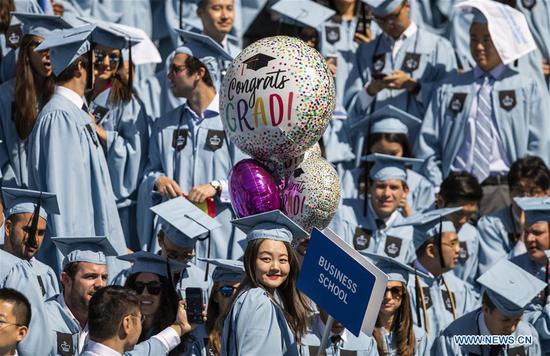Sino-U.S. student exchanges vital for ties
Student exchanges between China and the United States go a long way in fostering bilateral relations and play a vital role, participants at an online discussion said.
At the event organized by the U.S. Heartland China Association and the International Student Conferences, students and international education experts reviewed the history of U.S.-China student exchanges and affirmed their positive impact.
One of the speakers was Wang Junlong, a Chinese student of international relations at the University of Southern California.
Wang underwent a four-month internship at the U.S. Heartland China Association in the summer and helped run the forums for college students and pen pal projects for K-12 students in the U.S. and China.
The pen pal program allows Chinese and U.S. students to communicate online. "This offers them more flexibility to interact with each other. They write to each other on a weekly basis," Wang said. The students talk about their educational and cultural experiences, and share details of their daily life.
Wang said the idea was to reach out to the average students instead of focusing on just those who wanted to study abroad.
"We received overwhelmingly positive feedback from the teachers, students and parents," Wang said.
The Third Space program for college students gets Chinese and U.S. students to engage in discussion to debunk stereotypes and build relationships. The exchanges are personal, such as sharing their most memorable childhood experiences and important cultural traditions that they practice.
Another program tries to get international students to become involved in local communities to foster civilian diplomacy.
Wang himself is a good example of civilian diplomacy. In 2021, he and some other USC students founded the Bridge Cultural Exchange Academy, the first student-run public diplomacy organization at the university. The organization's mission is to foster student diplomacy through accessible and affordable cultural exchange summits and programs.
The organization has so far hosted three online cultural exchange summits, engaging 200 students from 15 countries. It has established partnerships with 12 nonprofit organizations in the U.S. and China.
The International Student Conferences launched the China-America Student Conference in 2020, a two-week program that brings Chinese and U.S. students together to conduct research on a particular theme connected to U.S.-China ties. Students from both countries can learn and understand each other's perspectives through the platform.
Vincent Lay, an executive member of the China-America Student Conference 2024 and a graduate student of industrial design at Arizona State University, said two weeks of being together allows intensive interaction among the participants.
Bahia Simons-Lane, executive director of the International Student Conferences, said such programs "go very far to change the way people think about others".
Yang Qianye, third secretary of education at the Chinese embassy in the U.S., said that student exchanges have been affected in recent years by political tensions between the two countries, and this could lead to damage in the long run.
"We cannot afford to have a generation growing up in isolation or having much mistrust and misunderstanding toward each other," she said.
Yang also pointed out that President Xi Jinping and U.S. President Joe Biden had agreed to expand exchanges, including in the field of education, during a meeting in San Francisco last month.
"It is our historical responsibility to push forward a frontier of human knowledge and usher in a new era of prosperity. So in this endeavor, China and U.S. educational exchanges will continue to play a vital role," she said.
At the event, she introduced the American Short-Term Study in China Initiative that the embassy offers.
"We hope we can help invite more American students to study in China," she said.

